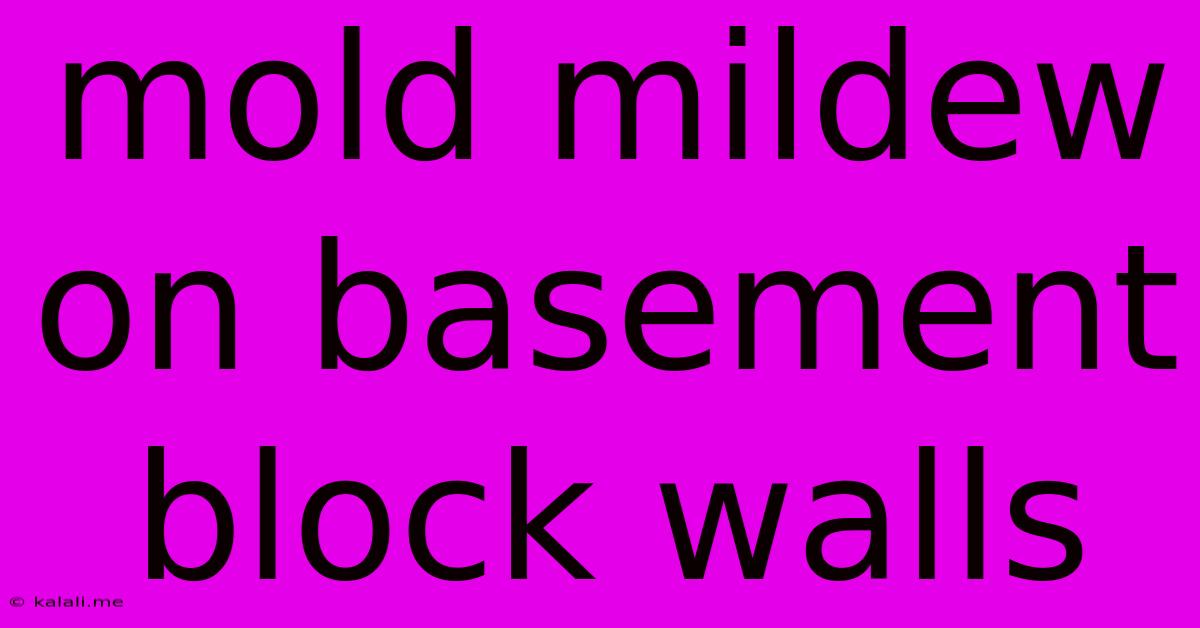Mold Mildew On Basement Block Walls
Kalali
Jun 03, 2025 · 3 min read

Table of Contents
Mold and Mildew on Basement Block Walls: A Comprehensive Guide to Identification, Prevention, and Remediation
Meta Description: Dealing with mold and mildew on basement block walls? This comprehensive guide covers identification, prevention, and remediation strategies to restore your basement's health and safety. Learn how to tackle this common problem effectively.
Basements, with their often-damp and cool environments, are prime locations for mold and mildew growth, particularly on porous surfaces like block walls. These fungi not only detract from the aesthetic appeal of your basement but also pose significant health risks, triggering allergies and respiratory problems. This guide will provide you with a thorough understanding of mold and mildew on basement block walls, covering identification, preventative measures, and effective remediation techniques.
Identifying Mold and Mildew on Basement Block Walls
Mold and mildew manifest in various ways, often appearing as discolored patches. Mildew typically presents as a powdery, white, gray, or black coating, while mold can exhibit a wider array of colors, including green, brown, orange, or even black, and often has a fuzzy or slimy texture. Pay close attention to areas with high humidity, such as near windows, pipes, or cracks in the walls. The smell is another key indicator; musty odors often accompany mold and mildew growth. If you suspect mold or mildew, avoid direct contact to prevent spore inhalation and potential health issues.
Understanding the Causes of Mold and Mildew Growth
Several factors contribute to the growth of mold and mildew on basement block walls:
- High Humidity: Excess moisture in the air is the primary driver. Poor ventilation, leaking pipes, and ground water seepage all contribute to high humidity levels.
- Water Leaks: Leaks from pipes, cracks in the foundation, or inadequate waterproofing allow moisture to penetrate the block walls, creating the perfect breeding ground for fungi.
- Poor Ventilation: Lack of proper ventilation traps moisture, preventing it from evaporating and promoting mold and mildew growth.
- Condensation: Cold block walls can cause condensation, especially during colder months, providing a surface for mold and mildew to thrive.
Preventing Mold and Mildew on Basement Block Walls
Prevention is key to avoiding costly and time-consuming remediation efforts. Implementing the following strategies can significantly reduce the risk of mold and mildew growth:
- Improve Ventilation: Install exhaust fans to remove moisture from the air, especially in areas prone to high humidity. Consider a dehumidifier to actively reduce moisture levels.
- Address Water Leaks: Repair any leaks promptly to prevent further moisture penetration. This may involve fixing leaky pipes, sealing cracks in the foundation, or improving exterior drainage.
- Waterproof Your Walls: Applying a waterproof sealant to the exterior and interior of your basement walls helps prevent water penetration.
- Maintain Proper Temperature and Humidity: Keep your basement's temperature and humidity levels within a healthy range. Aim for a relative humidity below 50%.
- Regular Cleaning: Regularly clean the walls to remove dust and debris, which can contribute to mold and mildew growth.
Remediation Strategies for Existing Mold and Mildew
If mold and mildew have already taken hold, you need to take immediate action:
- Assess the Extent of the Problem: Determine the size and severity of the infestation to decide on the appropriate remediation strategy. Large infestations often require professional assistance.
- Safety First: Wear appropriate personal protective equipment (PPE) including gloves, a mask, and eye protection when cleaning.
- Small Infestations: For small areas, you can attempt cleaning using a solution of water and bleach (1 part bleach to 10 parts water). Apply the solution, scrub the affected area, and then rinse thoroughly with clean water. Ensure proper ventilation during this process.
- Large Infestations: For extensive mold and mildew growth, it's best to consult a professional mold remediation specialist. They have the expertise and equipment to safely and effectively remove the mold and prevent future growth. They may use specialized cleaning agents and techniques to ensure complete eradication.
Remember, mold and mildew remediation is not a DIY project for large infestations. Professional assistance ensures the job is done thoroughly and safely, preventing potential health risks and long-term problems. Addressing mold and mildew effectively protects your health and preserves the structural integrity of your basement.
Latest Posts
Latest Posts
-
Acceleration As A Function Of Velocity
Jun 05, 2025
-
How To Repair Folding Closet Doors
Jun 05, 2025
-
Best Gta 5 Cars Story Mode
Jun 05, 2025
-
Center Vents Over Window Of In Room
Jun 05, 2025
-
How To Say Girlfriend In Spanish
Jun 05, 2025
Related Post
Thank you for visiting our website which covers about Mold Mildew On Basement Block Walls . We hope the information provided has been useful to you. Feel free to contact us if you have any questions or need further assistance. See you next time and don't miss to bookmark.